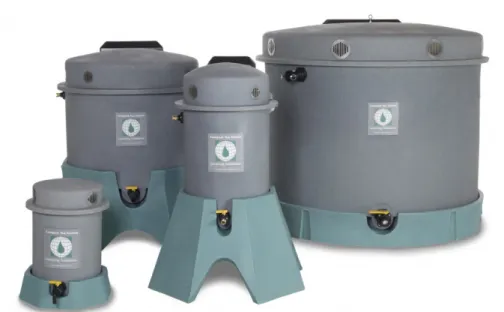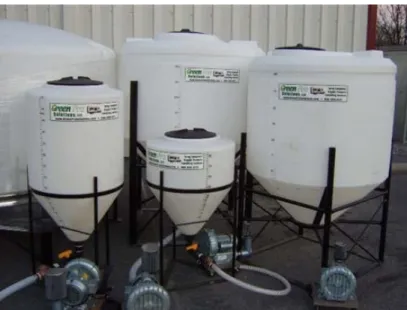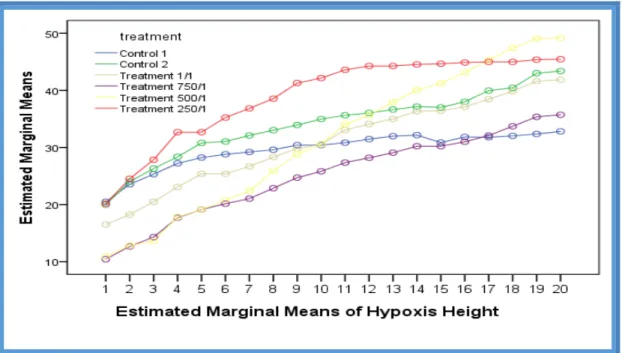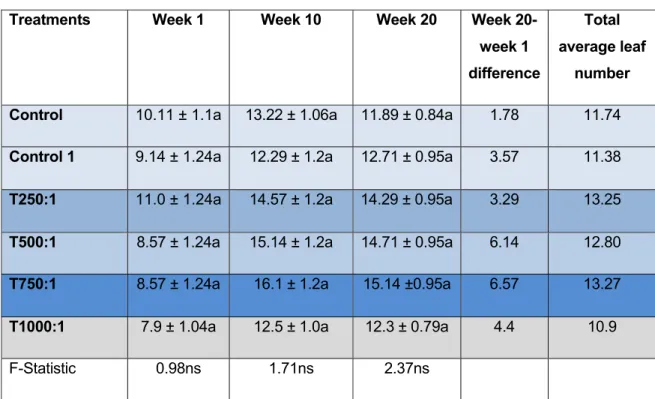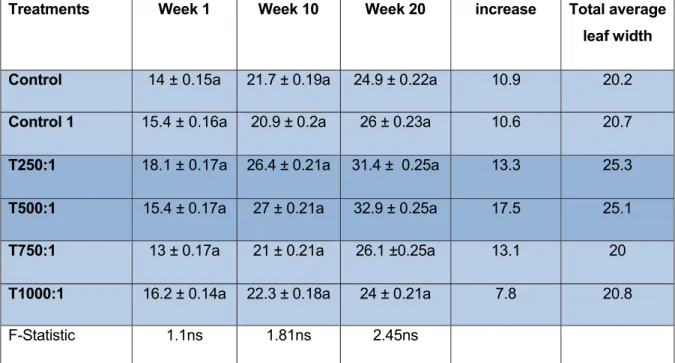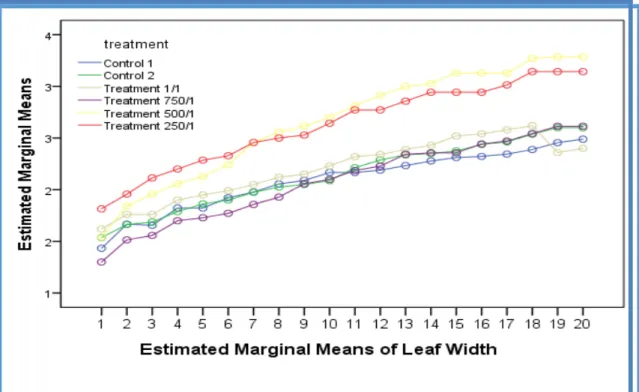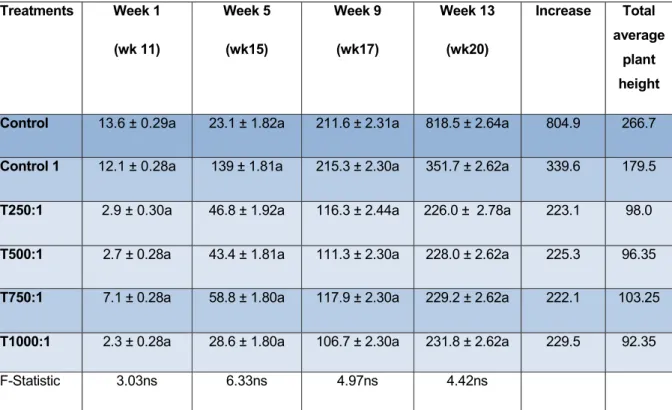CHAPTER FOUR: EFFECTS OF MUSHROOM COMPOST TEA EXTRACT ON CHLOROPHYLL CONTENT OF HYPOXIS HEMEROCALLIDEA AND SIPHONOCHILUS AETHIOPICUS. Figure 2.1: The cultivation solutions compost tea brewer system 10™, seen from the front and back with lid and pump.
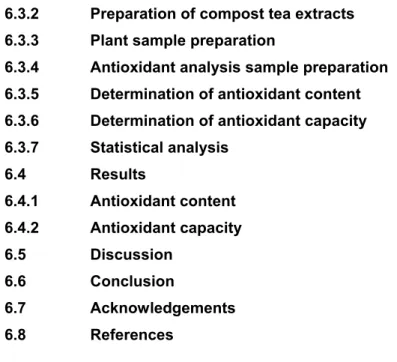
Chapter One
Research problem .1 Problem statement
- Research question
- Hypotheses
- Objectives Main objective
To determine the desired compost tea extract concentration on the physiological improvements/growth response (total shoot growth, plant height, number of leaves, leaf length, photosynthesis and chlorophyll content). To determine the effects of the compost tea extracts on soil nutrient levels and the availability of mineral elements (N, P, K, Ca, Mg, S, Fe, B, Mn, Cu and Zn).
Outline of the chapters
The fifth chapter evaluated the effects of mushroom compost tea extracts on weight, nutrients and mineral elements of the growth medium on the growth of H. The sixth chapter tested the effect of compost tea extracts on antioxidant capacity and H content.
Chapter Two
ABSTRACT
- Soil improvements both inorganic and organic
- The making of compost
- Mushroom compost: a source of compost tea
- The brewing of compost tea
Compost tea has also gained popularity in conventional agricultural crops with the current trend towards organic agricultural production (Theunissen et al., 2010). As the protein is degraded, the pH rises above 7 and ammonia is released (Rynk et al., 1992).
THE POSSIBLE EFFECTS OF COMPOST TEA ON SOIL MEDIUM IMPROVEMENT AND PLANT GROWTH
- Compost teas brewing systems and machinery
- Importance of growing Hypoxis hemerocallidea organically
- Importance of growing Siphonochilus aethiopicus organically
Environmental conditions such as evaporation, temperature and humidity can affect the quality of the compost tea extract. Chemical properties of the water can affect the quality of the compost tea extract produced (Martens, 2001; Ingham, 2005).
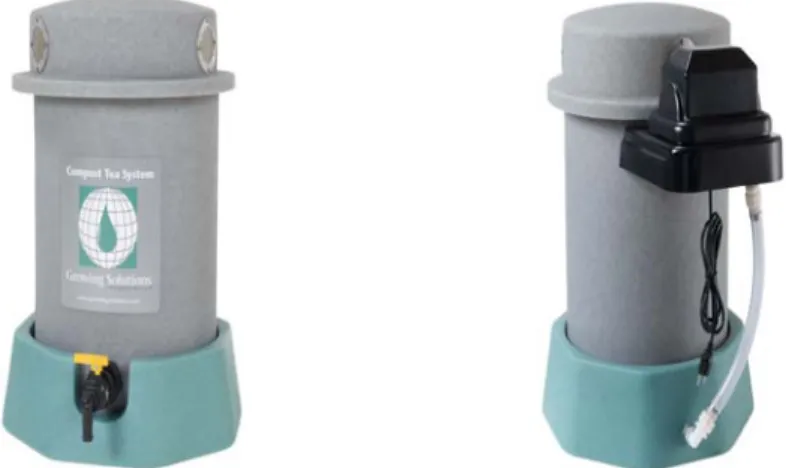
CONCLUSION
The germination of seeds can take up to one year; however, an easier way to propagate the plant is by division, while the rhizomes are dormant in winter. While micro-propagation has saved the species from extinction where wild populations are thought to have been almost completely depleted, the species remains on the listed data for Red Listed Species of South African Plants (SANBI, 2002).
ACKNOWLEDGEMENT
Effects of compost tea on soil fertility and plant growth of organic tomato (Solanum lycopersicum Mill) compared with different organic fertilizers. Simultaneous application of compost tea and inorganic fertilizer on growth, yield and terpenoid content of Centella asiatica (L) urban.
Chapter Three
ABSTRACT
INTRODUCTION
- Hypoxis hemerocallidea
Various studies have demonstrated that beneficial organisms help prevent disease when compost tea is applied to plant leaves (Scheuerell, 2004; Ingham, 2005; Souleymane et al., 2009; Marin et al., 2013). Compost tea has also become popular in conventional agriculture with current trends in organic farming (Theunissen et al., 2010).
MATERIALS AND METHODS .1 Plant material
- Preparation of the compost tea extract
The second aerobic brew was with 100 ml of compost tea catalyst added to the 500 g of mushroom compost: 40 liters of water. The interaction between the effect of growing time and the effect of the compost tea extract on both species was also analyzed.
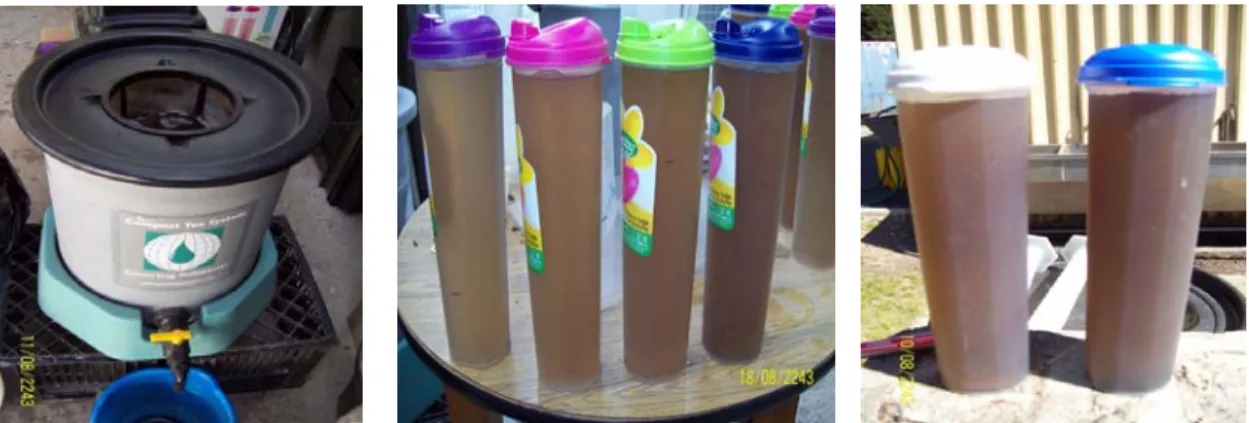
RESULTS
- The growth results of Hypoxis hemerocallidea
- The effects of compost tea extract on plant height (mm) of Hypoxis hemerocallidea
- The effects of compost tea extract on leaf count (n) of Hypoxis hemerocallidea
- The effects of compost tea extract on leaf length (mm) of Hypoxis hemerocallidea
- The effects of compost tea extract on leaf width (mm) of Hypoxis hemerocallidea
- Growth results of Siphonochilus aethiopicus
- The effects of compost tea extract (CTE) on plant height (mm) of Siphonochilus aethiopicus
- The effects of compost tea extract on leaf length (mm) of Siphonochilus aethiopicus
- The effects of compost tea on leaf width (mm) of Siphonochilus aethiopicus
- Hypoxis hemerocallidea
The Hypoxis tubers showed an increase in growth responses from the start of the experiment, while the Siphonochilus rhizomes responded to the compost tea treatments only seven weeks later. These positive growth effects of compost tea are consistent with reports in other studies by Gomez-Brandon et al. The plants could have shown better growth response averages over a longer trial period (at least another season) to determine the effect of the compost tea extract and gain a better insight.
The extract of compost tea will depend on the source of the compost, the cooking method and the additives added to enrich the compost tea (Ingham 2005).
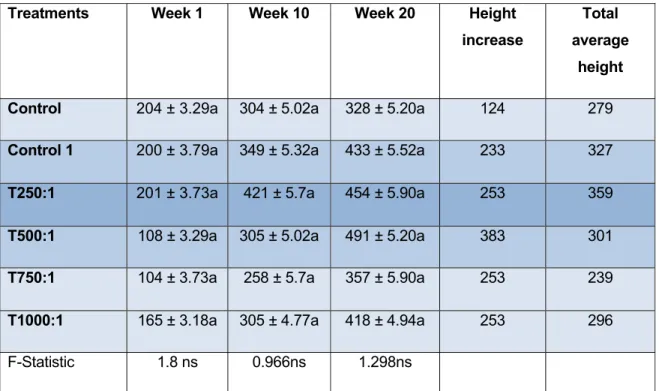
CONCLUSION
Overall, these results show that CTE had little/negative effect on the average growth responses of the plants. The many positive effects of compost tea were also reported by Gomez-Brandon et al. 2013) reported that a weekly foliar application of microbially enriched CTE can be successfully used as a bio-fertilizer and bio-protection agent on melon crops without compromising fruit quality. It is speculated that due to the slow growth of the species, the fact that few leaves were recorded, the CTE may have been incorporated into the rhizomes of Siphonochilus.
Compost tea has gained popularity in conventional agriculture with the current production trends of organic agriculture (Theunissen et al., 2010).
ACKNOWLEDGEMENTS
The use of CTE as an organic growth stimulant continues to gain popularity and can be beneficial for Hypoxis and Siphonochilus medicinal species. However, it appears that because both species are slow growing (with growth from the storage organs underground), Hypoxis is a tuber and Siphonochilus is a rhizome, further research is recommended, over two growing seasons, to evaluate the effect of CTE for these. species over a longer period of time.
Compost tea and poultry waste extract: Alternative organic management methods for stem canker of potato caused by Rhizoctonia solani. Fortification of potassium silicate with compost tea and seaweed extract for managing dollar spot (Sclerotinia homoeocarpa) of turf. Foliar application of microbially enriched compost tea increases the growth, yield and quality of muskmelon (Cucumis melo L.) grown under fertigation system.
The effect of compost extract on the yield of strawberries and the severity of Botrytis cinerea.
Chapter Four
- ABSTRACT
- Chlorophyll production in plants
- Siphonochilus aethiopicus
- Materials and methods
- Experimental setup
- Preparation of the compost tea extract
- Chlorophyll content determination
- Measuring leaf colour
- Statistical analysis
- RESULTS
- Leaf chlorophyll content (Chl/mg²) of Hypoxis hemerocallidea
- Leaf chlorophyll content (Chl/mg²) of Siphonochilus aethiopicus
- The effects of CTE on leaf colour of Hypoxis hemerocallidea
- The effects of CTE on leaf colour of Siphonochilus aethiopicus
- DISCUSSION
- CONCLUSION AND RECOMMENDATIONS
- ACKNOWLEDGEMENTS
- REFERENCES
At the eighth week of the experiment, the mean leaf chlorophyll content per treatment varied as follows: Control = 74; Control 1. There was no significant difference in the effect of the treatments on leaf color over the twenty weeks. There was no significant difference between the treatments on leaf color over the twenty weeks.
Although the CTE treatments had no significant effect on chlorophyll and leaf greening, it was possible that most of the compost tea extract was absorbed into the Siphonochilus rhizomes.
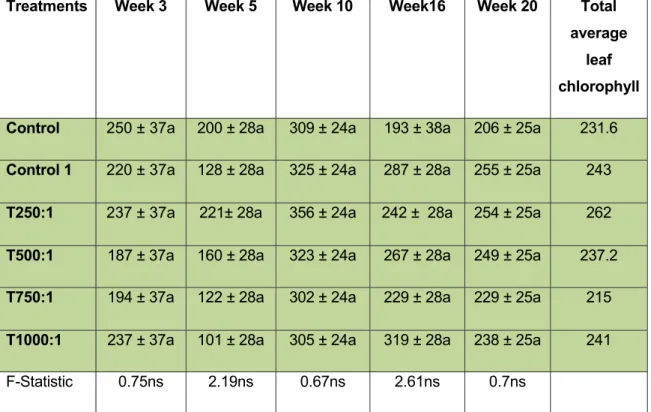
Chapter Five
ABSTRACT
The dry leaf analysis revealed that sodium (Na) levels in treatments T500:1 and T250:1, respectively, were significantly lower than control 1.
INTRODUCTION
- Hypoxis hemerocallidea
- Siphonochilus aethiopicus
- Compost tea extracts
- Nutrient concentrations in indigenous corms and rhizomes, plants, fruit, and vegetables
Various studies have proven that beneficial organisms help prevent disease when compost tea is applied to plant leaves (Scheuerell, 2004; Ingham, 2005; Souleymane et al., 2009). The effects of non-aerated compost tea consisting of ruminant and municipal solid waste (MSW) on strawberries resulted in different nutrient contents in the fruit (Hargreaves et al., 2008). Aerated compost tea applied to raspberry plants resulted in lower fruit and leaf K levels, with year-to-year variation in nutrient levels (Hargreaves et al., 2008-Raspberry).
Nutrient uptake in plant tissues of pak choi (Brassia rapa cv. Bonsai) varied among treatments (Pant et al., 2009).
MATERIALS AND METHODS
- Plant material
- Preparation of the compost tea extract
- Data collection
- Statistical analysis
- The total wet analysis of Hypoxis hemerocallidea
- The total dry weight analysis (g) of Hypoxis hemerocallidea
- The dry soil analysis (g.) soil sample of Hypoxis hemerocallidea
- The total dry leaf nutrient analysis (mg.) of Hypoxis hemerocallidea
- The total nutrient analysis (mg) of Hypoxis hemerocallidea dried roots
- The total wet analysis (cm. and g.) of Siphonochilus aethiopicus
- The total dry analysis (g) of Siphonochilus aethiopicus
- The dry soil sample analysis (mg.) of Siphonochilus aethiopicus
- The total dry leaf nutrient analysis (mg.) of Siphonochilus aethiopicus
- Hypoxis hemerocallidea
- Siphonochilus aethiopicus
Control had the highest copper content; T500:1 had the highest zinc content and control had the highest boron content (Table 5.5). Control had the highest level of manganese (Mn), iron (Fe), copper (Cu), zinc (Zn) and boron (B). The dry leaf analysis revealed significant differences between the treatments in sodium (Na) (in T500:1 and T250:1 - the lowest), manganese (Mn), with control 1 and T1000:1 having the lowest levels.
Control had the lowest zinc (Zn) levels, while the rest of the treatments were higher from 40.3 mg to 50 mg.
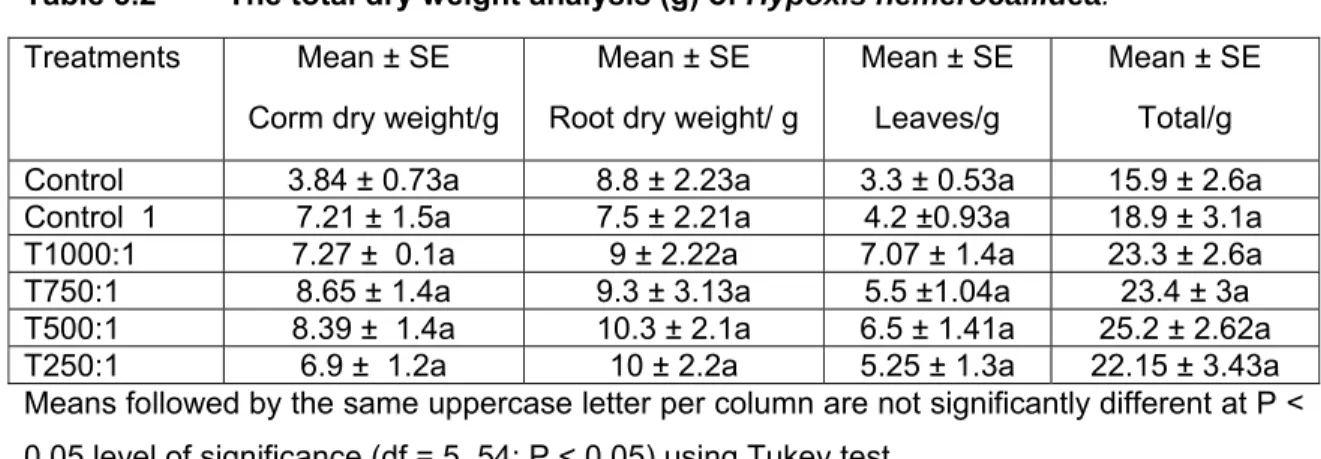
CONCLUSION
In general, when comparing the nutrient levels (N; P; K; Ca) in Lachenalia and Ornithogalum (Claassens, 1990), also two indigenous bulbs with Hypoxis and Siphonochilus, the nitrogen (N), potassium (K) and calcium (Ca) levels was lower in Lachenalia and Ornithogalum than Hypoxis and Siphonochilus.
The effects of organic and conventional nutritional modifications on strawberry cultivation: fruit yield and quality. Release Characteristics and Control of Nitrogen, Phosphate, Organic Matter from Used Mushroom Compost Amended Soil in a Column Experiment. Effects of compost tea treatments on the productivity of lettuce and kohlrabi systems under organic crop management.
Effects of spent mushroom composting on quality and productivity of cucumber (Cucumis sativus L.) grown in greenhouses.
Chapter Six
Abstract
Introduction
- General background
- Hypoxis hemerocallidea
- Siphonochilus aethiopicus
- Compost tea extracts
In addition to its unique and distinctive morphology, the Swati people use wild ginger to treat malaria and menstruation by chewing the fresh rhizomes and roots (Van Wyk et al., 1997). The aromatic roots are said to be used by the Zulu people to ward off lightning (Van Wyk et al., 1997). Further medicinal studies with wild ginger confirmed the treatment of pain and inflammation (Fennell et al., 2004).
Further research confirmed both antibacterial and antifungal activities in rhizomes and leaves of wild ginger (Coopoosamy et al., 2010).
Materials and methods
- Plant material
- Preparation of the compost tea extract
- Plant sample preparation
- Antioxidant analysis sample preparation
- Determination of the antioxidant content
- Total polyphenol, flavonol and flavanone content
- Ferric reducing antioxidant power (FRAP)
- Oxygen radical absorbance capacity (ORAC)
- Statistical analysis
Compost tea is a water extract of compost that is brewed in such a way that the beneficial organisms, i.e. This research project focused specifically on the effect of the different concentrations of compost tea extract on the antioxidant content and capacity of two South African bulbous species. The compost tea catalyst and compost tea brewing were prepared according to the manufacturer's instructions.
The second aerobic brew consisted of a 100 ml of compost tea catalyst added to the 500 g of mushroom compost per 40 L of water.
Results
- Antioxidant content
- Antioxidant capacity
- Ferric reducing antioxidant power (FRAP)
- Oxygen radical absorbance capacity (ORAC)
The lowest total flavonol content was found in the compost treatment with no catalyst (CEO). The highest flavonol reading was found in the HUB treatment with a value of 4.06 mg (Figure 6.4). No significant differences were found in the flavanol content of the control (C), T250:1 and T750:1 compost tea treatments.
There were no significant differences in the FRAP values in all the compost tea treatments for S.
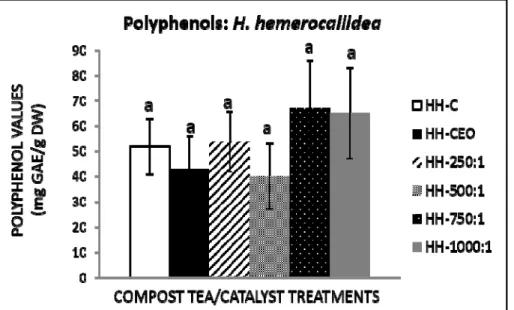
DISCUSSION
The total phenolic content and antioxidant activity were found to be generally higher in the leaves (due to exposure to sunlight) than the rhizomes of 14 ginger species. A study conducted on Allium cepa revealed higher total flavonoid content and FRAP (ferric reducing antioxidant power) capacity values (Sulaiman et al., 2011) compared to the Hypoxis and Siphonochilus values. Fresh fennel bulbs have higher antioxidant activity (Rawson et al., 2011), compared to the Hypoxis and Siphonochilus values.
In both species, the compost tea treatments had no significant effect on the ORAC of the underground storage organs (Figures 6.8 and 6.9).
CONCLUSION
Therefore, this study provided insights into the growth habits and compost tea treatments of two complex plant species. It was therefore worthwhile to determine the effect and rate of application of mushroom compost tea extracts for the future cultivation of H. Although the species received the same dose at the same day and time, they reacted differently and then gave different results.
Based on the results above, it is recommended that a full strength mushroom compost be used to generally increase the antioxidant activity of H.
Acknowledgements
Phenolic compounds and antioxidant activity of bulb extracts of six Lilium species native to China. Domestic processing of onion bulbs (Allium cepa) and asparagus spears (Asparagus officinalis): effect on flavonol content and antioxidant status. Effect of cooking and roasting on the polyacetylene and polyphenol content of fennel (Foeniculum vulgare) bulb.
Analysis of Total Phenols and Other Oxidation Substrates and Antioxidants by Folin-Ciocalteu Reagent.
Chapter Seven
ACKNOWLEDGEMENTS
Chapter Eight
The effect of micronutrients (B, Zn and Fe) foliar application on the growth, flowering and garlic production of gladiolus (Gladiolus grandiflorus L.) in calcareous soils. Effect of types of organic manure on growth, yield and quality parameters of ginger (Zingiber officinale). Potential of vermicompost produced from plant waste on the growth and nutrient status in vegetable production.
The potential of South African plants in the development of new food and beverage products.
